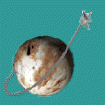
Current Issues:
SpaceViews
SpaceViews Update
Breaking News
Back Issues
Search
Subscriptions
Submissions
Forum
Space Sites of the Week
Home
Mars Pathfinder
Comet Hale-Bopp
Top Ten Stories of '96
Life on Mars?
Pathfinder Lands on Mars, Deploys Rover
The Mars Pathfinder spacecraft successfully landed on the surface of the Red Planet July 4, the first landing on Mars since the Viking missions 21 years ago.
![[image of rover shortly after landing]](../970715/images2/rovercolor.jpg) After a few technical problems were resolved, the Sojourner rover rolled off the Pathfinder lander late July 5 and began to explore the Martian terrain around the lander.
After a few technical problems were resolved, the Sojourner rover rolled off the Pathfinder lander late July 5 and began to explore the Martian terrain around the lander.
"The little engine that could, did," said flight systems chief engineer Rob Manning after the flawless landing.
To the surprise of Pathfinder engineers, radio signals from the spacecraft were received as it entered the Martian atmosphere and descended to the surface. They were able to get a radio signal confirming the spacecraft had successfully landed on the surface at around 1:08pm EDT (1708 UT), when they expected the low altitude of Earth in the Martian sky would prevent any signal from reaching Earth.
The lander bounced a number of times, including a 15-m (50-ft) first bounce after landing. Pathfinder came to rest on its base petal, eliminating the need to right the spacecraft using one of the other petals. The spacecraft also landed at only a 2 to 3 degree angle to the surface, which was considered "quite flat" by Pathfinder team members.
At about 7:35pm EDT (2335 UT), six and a half hours after landing, the first black-and-white images from Pathfinder were returned to Earth, confirming the lander was in excellent shape and providing a first glimpse of the rocky terrain around the landing site.
The first color images were returned a couple hours later. They showed a landscape superficially similar to that seen by the two Viking landers. However, the Pathfinder lander could see a pair of hills in the distance. Later images showed a greater diversity in the type and color of rocks seen around the Pathfinder landing site than with the Viking sites.
The original plan called for release of the rover the first day on the planet, but several problems cropped up to prevent the rollout of Sojourner. The airbags around the petal where the rover was mounted were not completely retracted and interfered with the deployment of the rover ramps, so the petal was moved up again to allow more of the airbag to be pulled in.
![[image of lander and landscape from rover]](../970715/images2/landerview.jpg) Later, a communications problem between the rover and lander kept instructions from getting to the rover, or data to be returned from the rover. On Saturday July 5, though, the problem disappeared, likely after the computers on Pathfinder were reset.
Later, a communications problem between the rover and lander kept instructions from getting to the rover, or data to be returned from the rover. On Saturday July 5, though, the problem disappeared, likely after the computers on Pathfinder were reset.
The front and rear ramps were then deployed and although the front ramp apparently did not reach the ground, Sojourner was able to roll down the rear ramp onto the Martian surface by late Saturday night.
Mission manager Richard Cook concluded that the July 4 had been a "really spectacular day" and noted that everything had gone so well he and other were left wondering if it had been the real thing of just a simulation.
That question was answered by project meteorologist John Schofield, who said it was nothing like the simulations; in their simulations "something went wrong all the time!"
"This is nirvana for us," said deputy project manager Brian Muirhead. "It's a wonderful celebration for the Fourth of July."
